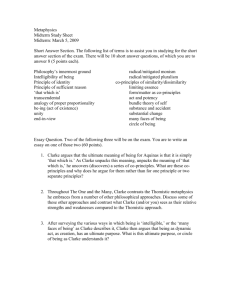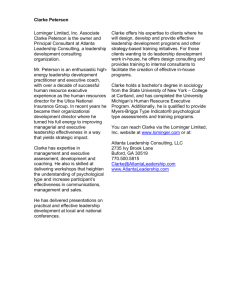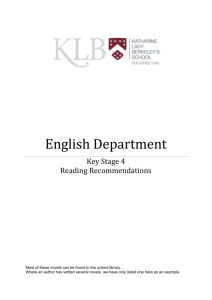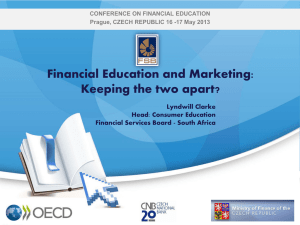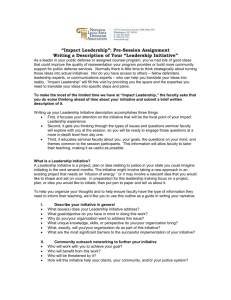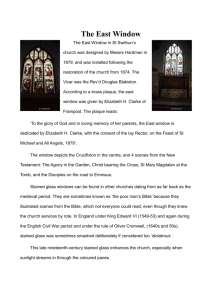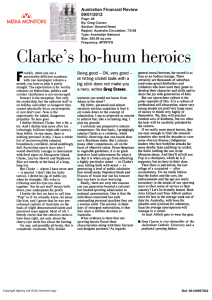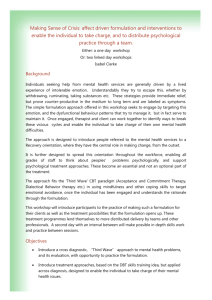Systemic Semiotic Design Practice:
advertisement
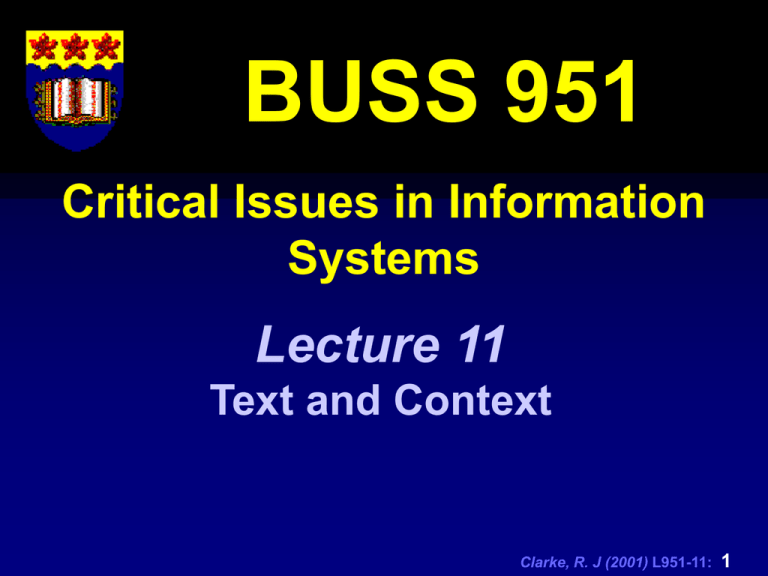
BUSS 951 Critical Issues in Information Systems Lecture 11 Text and Context Clarke, R. J (2001) L951-11: 1 Recall last lecture we looked at language in the workplace useful for analysing workpractices in workplaces we have seen in tutorials that work practices, both manual and computer based, can be theorised as texts Clarke, R. J (2001) L951-11: 2 Agenda rather than using signs, we use texts- signs can be difficult to apply in practice and are a very small unit of analysis we will use systemic-functional linguistics as a way of analysing workpractices in workplaces language or texts becomes an analytical technology Clarke, R. J (2001) L951-11: 3 Evaluation of Semiotic Analysis Clarke, R. J (2001) L951-11: 4 Semiotic Analysis Criticisms (1) sometimes semioticians present their analyses as if they were objective, scientific accounts rather than subjective interpretations some semiotic analysis has been criticised as nothing more than arid formalism Clarke, R. J (2001) L951-11: 5 Semiotic Analysis Criticisms (2) in structuralist semiotics the focus is on langue rather than parole (Saussure's terms) on formal systems rather than on processes of use and production. structuralism was primarily interested in studying structures in language Clarke, R. J (2001) L951-11: 6 Semiotic Analysis Criticisms (3) Valentin Volosinov (Bakhtin) argues that the prime determinant of a sign is not its relationship to other signs but rather the social context of its use (Fiske 1992: 299). Semiotics can appear to suggest that meaning is purely explicable in terms of determining structures Clarke, R. J (2001) L951-11: 7 Semiotic Analysis Criticisms (4) purely structuralist semiotics does not address authorial intentions or audience interpretation it ignores particular practices, institutional frameworks and the cultural, social, economic and political contexts Clarke, R. J (2001) L951-11: 8 Semiotic Analysis Strengths (1) semiotics emphasizes that signs are related to their signifieds by social conventions which we learn we become so used to such conventions in our use of various media that they seem natural or commonsense Clarke, R. J (2001) L951-11: 9 Semiotic Analysis Strengths (2) Examples: television or photography becomes a 'a window on the world'. computers make organisations efficient and effective this is an ideological issue, since, “an ideology is the sum of taken-forgranted realities of everyday life” (Burgin 1982: 46). Clarke, R. J (2001) L951-11: 10 Semiotic Analysis Strengths (3) semiotics can help to make us aware of what we take for granted in representing the world we are always: dealing with signs, not with an unmediated objective reality that sign systems are involved in the construction of meaning Clarke, R. J (2001) L951-11: 11 Semiotic Analysis Strengths (4) it can be difficult for us to realize the conventional nature of such relationships. when we take these relationships for granted we treat the signified as unmediated or 'transparent' or commonsense Clarke, R. J (2001) L951-11: 12 Text and Non-Text Clarke, R. J (2001) L951-11: 13 Text and Non-Text knowing when we do not have texts is very important! one way of defining the difference between Computing Science and Information Systems fields (in Aust., Britain, Nth America) is based on the non-text/text distinction... Clarke, R. J (2001) L951-11: 14 Information Systems Text and Non-text Information Systems Culture, Institutions, Organisations, Communications Field in social use: Computer Centres, Text Business Data Processing etc. Non-text Computing Science Field Operating Systems, File Systems Compilers, Loaders, Linkers, Machine Architecture Clarke, R. J (2001) L951-11: 15 Information Systems Text and Non-text we can see from the previous slide, that the objects of interest in computing science are basically all non-text the exact opposite is true of IS! however in conducting IS studies in organisations we are faced with a methodological problem... Clarke, R. J (2001) L951-11: 16 Text and Non-Text sometimes it is not possible to directly acquire relevant texts in organisational applications stictly speaking non-texts are unanalysable using SFL many situations could be classed as nontexts Example 1: The Lone User Example 2: Past Workpractices Clarke, R. J (2001) L951-11: 17 Example 1: Lone User Computer based tool user working in apparent isolation in the organisation this situation is referred to as the Iexperience by Bakhtin (Volosinov in Innis ed/ 1985, 54-56). Whatever may be going on is happening inside the head of the user, about which nothing linguistically can be said. Clarke, R. J (2001) L951-11: 18 Example 2: Past Workpractices trying to analyse a past work practice an analyst may occasionally find objects which provide clues to a workpractice which no longer exists must be addressed in longitudinal (that is long-term) studies Clarke, R. J (2001) L951-11: 19 Empty Corpus Problem (1) Methodologically, these two examples are instances of the empty corpus problem (Andersen 1992) Both previous examples are unanalysable using systemicfunctional linguistics Clarke, R. J (2001) L951-11: 20 Empty Corpus Problem (2) Partially Resolved However, it is possible to transform an unanalysable empty corpus into a situation in which a text is produced: probing for, or eliciting, a text in a situation in which we would normally not expect one in fact SFL can help us determine the best way to achieve this transformation! Clarke, R. J (2001) L951-11: 21 Context and Text Clarke, R. J (2001) L951-11: 22 Context and Text SFL Semiotic Model of Language used Systemic Functional Linguistic (SFL) theory to provide actual methods for conducting applied linguistic analysis of texts (Halliday 1985) the Stratal Model of SFL (Martin 1992) is derived in subsequent slides- useful in identifying which strata, systems, and units to consider in a specific study Clarke, R. J (2001) L951-11: 23 Context and Text Realisation every text refers to its social context- we use the term ‘social context’ in the broadest way must do so in order to be meaningful that is to communicate something to someone in order to model the relationship between language and social context we use concentric ovals one semiotic system (language) is a realisation of another more abstract one (social context) Clarke, R. J (2001) L951-11: 24 Social Context and Language Redounding how language realises context is called redounding language construes social context, language is construed by social context, and language reconstues social context ... a relationship of mutual determination and interdependency NOT simple cause and effect Clarke, R. J (2001) L951-11: 25 Context and Text SFL Context and Text Context Text solidary relationshipthat is a relationship of unity- between texts and contexts context predicts text, text construes context note the similarity to Hjelmslev’s concepts a major influence for Martin’s reformulation of Halliday Clarke, R. J (2001) L951-11: 26 Context and Text SFL Bi-stratal Organisation of Context Cultural Context Situational Context Language two types of context recognised by the theory (after Malinowski) Situational Context which provides secific situational ‘values’ to the text Cultural Context which provides a pattern or template that is portable across different situations within a national or organisational culture Clarke, R. J (2001) L951-11: 27 Context and Text SFL Contextual Strata Genre Register Cultural Context is represented in SFL by Genre text staging involving sequence, selection, and iteration Language Clarke, R. J (2001) L951-11: 28 Social Context and Language Genre this kind of patterning was referred to in tutorials as Genre this patterning is like a template we can apply it in circumstances in which the immediate situation may not be known (buying goods in a foreign country) Clarke, R. J (2001) L951-11: 29 Social Context and Language Genre Genre forms a context related to “culture” and is referred to as the Context of Culture genre is a kind of generalised text type: novel film service encounter Clarke, R. J (2001) L951-11: 30 Social Context and Language Genre: Several Theories now it so happens that there are two major views on genre the first is that genre is simply the unique instance of field, tenor and mode (also called Contextual Configuration) this is the model of genre theorised by Hasan Clarke, R. J (2001) L951-11: 31 Social Context and Language Genre: Several Theories in your reading, the ALABS system is looked at from this point of view initially- but it has some problems when looking at IS in organisations the alternative way of looking at genre is to treat it in exactly the same way as the rest of the SFL model ie/ as its own strata Clarke, R. J (2001) L951-11: 32 Social Context and Language Genre: Several Theories for various reasons genre as a strata (after Martin) is much better way of looking at IS like everything is SFL: linguistic resources form systems available to language usersgenre should also be treated in this way IS appear to have some strange characteristics- they are multigeneric by nature Clarke, R. J (2001) L951-11: 33 Context and Text SFL Contextual Strata Genre Register Language Situational Context is represented in SFL by Register consisting of field- social action and activities, tenorwho is involved in the language, and mode- how language is used Clarke, R. J (2001) L951-11: 34 Social Context and Language Register we have also started to analyse texts in terms of their field, tenor and mode field- social activities and actions tenor- who is doing what to whom mode- how language is used these attributes were called Register or Context of Situation Clarke, R. J (2001) L951-11: 35 Social Context and Language Register but we also said that we could identify an extra type of context a kind of patterning exists in texts which is separate from the immediate situation (field, tenor and mode) the patterning is portable across different situations Clarke, R. J (2001) L951-11: 36 Language and Social Context Clarke, R. J (2001) L951-11: 37 Language and Social Context Language as a Semiotic System unlike most semiotic systems, the meanings in language (content) are not directly realised into sounds or letters (expression) language is a semiotic system consisting of three levels Clarke, R. J (2001) L951-11: 38 Language and Social Context Language as a Semiotic System recall Saussure’s concept of the sign = signifer + signified content, or the meanings of language (signified), utilise two levels meanings are realised in wordings (that is words and grammar) then, wordings are realised by an expression consisting of sounds and letters Clarke, R. J (2001) L951-11: 39 Context and Text SFL Tri-stratal Organisation of Language Genre Register Meanings Wordings Expression unlike most semiotic systems, the meanings in language (content) are not directly realised into sounds or letters (expression) language is tristratal; the content (signified) involves meanings and wordings Clarke, R. J (2001) L951-11: 40 Context and Text SFL Language Strata Genre Register Discourse Semantics Lexico-grammar Phonology Graphology meanings of a text are associated with the strata of Discourse Semantics… …are in turn realised in wordings (words and grammar) are associated with the strata of Lexicogrammar …are in turn given expression (sounds and letters) with the strata of Phonology/Graphology Clarke, R. J (2001) L951-11: 41 Context and Text SFL Metafunctions Genre Register field Discourse Semantics tenor interpersonal mode experiential textual Lexico-grammar Transitivity Mood Theme Phonology Graphology while strata are responsible for major language units, metafunctions are responsible for the kinds of meanings simultaneously conveyed in texts: ideational metafunctionconcerned with action interpersonal metafunctionconcerned with reflection textual metafunctionconcerned with connection Clarke, R. J (2001) L951-11: 42 Context and Text SFL Ideational Metafunction resolved in language as two distinct components- Genre Register field Discourse Semantics tenor interpersonal mode experiential textual Lexico-grammar Transitivity Mood Theme Phonology Graphology experiential meaning: expression of processes and other phenomena in the social world including the speakers’ own consciousness logical meanings: involves the mapping of experiential meanings into language Clarke, R. J (2001) L951-11: 43 Context and Text SFL Interpersonal Metafunction the metafunction of language by which: Genre Register field Discourse Semantics tenor interpersonal mode experiential social groups are delimited and the individual is identified, represented and reinforced textual Lexico-grammar Transitivity Mood Theme Phonology Graphology Clarke, R. J (2001) L951-11: 44 Context and Text SFL Textual Metafunction refers to the way the text is organised as a piece of writing Genre Register field Discourse Semantics tenor interpersonal mode experiential textual Lexico-grammar Transitivity Mood Theme Phonology Graphology Clarke, R. J (2001) L951-11: 45 Integration Strata & Metafunction Clarke, R. J (2001) L951-11: 46 Discourse Semantics Metafunctions discourse semantics is the first content layer in SFL model of language three kinds of meanings (metafunctions) are conveyed simultaneously in texts ideational meanings interpersonal meanings textual meanings Clarke, R. J (2001) L951-11: 47 Discourse Semantics Ideational Metafunction ideational metafunction resolved in language as two distinct components- experiential and logical meanings experiential meanings: expression of processes and other phenomena in the social world including the speakers own consciousness logical meanings: involves the mapping of experiential meanings into language Clarke, R. J (2001) L951-11: 48 Discourse Semantics Interpersonal and Textual Metafunctions interpersonal metafunction: social groups are delimited the individual is identified and reinforced textual metafunction: refers to the way the text is organised as a piece of writing (or speech) Clarke, R. J (2001) L951-11: 49 Discourse Semantics & Register Solidarity it so happens that there is a relationship (solidarity) between register and discourse semantics: Register Discourse-Semantics field tenor mode ideational interpersonal textual Clarke, R. J (2001) L951-11: 50 Lexico-grammar second content level in SFL metafunctions of discourse semantics are rendered into words (lexis) and grammar consists of: transitivity mood theme Clarke, R. J (2001) L951-11: 51 Lexico-grammar Transitivity involves: who is doing what to whom when where why and how Mood involves: type of clauses, the degree of certainty or obligation expressed, the use of attitude words, politeness markers Theme involves: patterns of foregrounding and continuity in the organisation of clauses Clarke, R. J (2001) L951-11: 52 LG & Discourse Semantics Solidarity it so happens that there is a relationship (solidarity) between discourse semantics and lexicogrammar: Discourse-Semantics LG ideational interpersonal textual transitivity mood theme Clarke, R. J (2001) L951-11: 53 SFL Model of Language these solidarities across strata can be added to our SFL diagram shows how parts of each strata are involved in helping to produce texts see Handout... Clarke, R. J (2001) L951-11: 54 Context of Culture Genre Register Context of Situation field Discourse Semantics tenor mode experiential interpersonal textual Lexico-grammar Transitivity Language Mood Theme Phonology Graphology Clarke, R. J (2001) L951-11: 55 Context and Text Appropriate SFL Methods stratal SFL model has useful properties, eg. for a given study appropriate linguistic methods can be determined in advance for workpractices associated with IS, metthods must be selected that emphasise the relationship between a text and its context, rather than the language system methods associated with the (organisational) of IS are used in the case Clarke, R. J (2001) L951-11: 56 SFL and Information Systems Clarke, R. J (2001) L951-11: 57 Language and social context Applied to IS SFL gives two complementary perspectives can look at the perspective of language: IS as communication (text) can look at the perspective of context: IS as social organisation Clarke, R. J (2001) L951-11: 58 Language and social context Applied to IS applying SFL to examining systems is very different to traditional IS approaches a given text provides only a partial perspective about a work practice in the short term a linguistic analysis provides only a small part of the overall picture Clarke, R. J (2001) L951-11: 59 Language and social context Applied to IS traditional IS practices are applied top-down: gives a very broad picture poor on details SFL methodology is applied bottomup: provides a very detailed view of work practices which then need to be integrated across various sites Clarke, R. J (2001) L951-11: 60 Language and social context Applied to IS need to look at many actual texts in a social context in order to find out about work practices only by shunting between language and social context (the work practice and the organisation) can we perform a meaningful analysis Clarke, R. J (2001) L951-11: 61 Language and social context Applied to IS in your last substantive assignment you were asked to collect a single text (of a transaction) you would need to collect many texts of the same type of transaction before you understood it (see all the variations) Clarke, R. J (2001) L951-11: 62 Language and social context Applied to IS how many texts to collect?: well its difficult to know you need to include those people involved in the work practices into the analysis so this SFL approach to understanding work practices MUST be participative Clarke, R. J (2001) L951-11: 63 SFL and IS not all the SFL model needs to be used on each text- what language resources you use will depend on the type of analysis needed for IS the most useful strata and context (genre and register) and discourse semantics Clarke, R. J (2001) L951-11: 64 SFL and IS IS are interesting because they are multigeneric, many genres are involved in describing the general properties of texts end-user modification of system and wholesale management driven change can be characterised using genre... Clarke, R. J (2001) L951-11: 65
